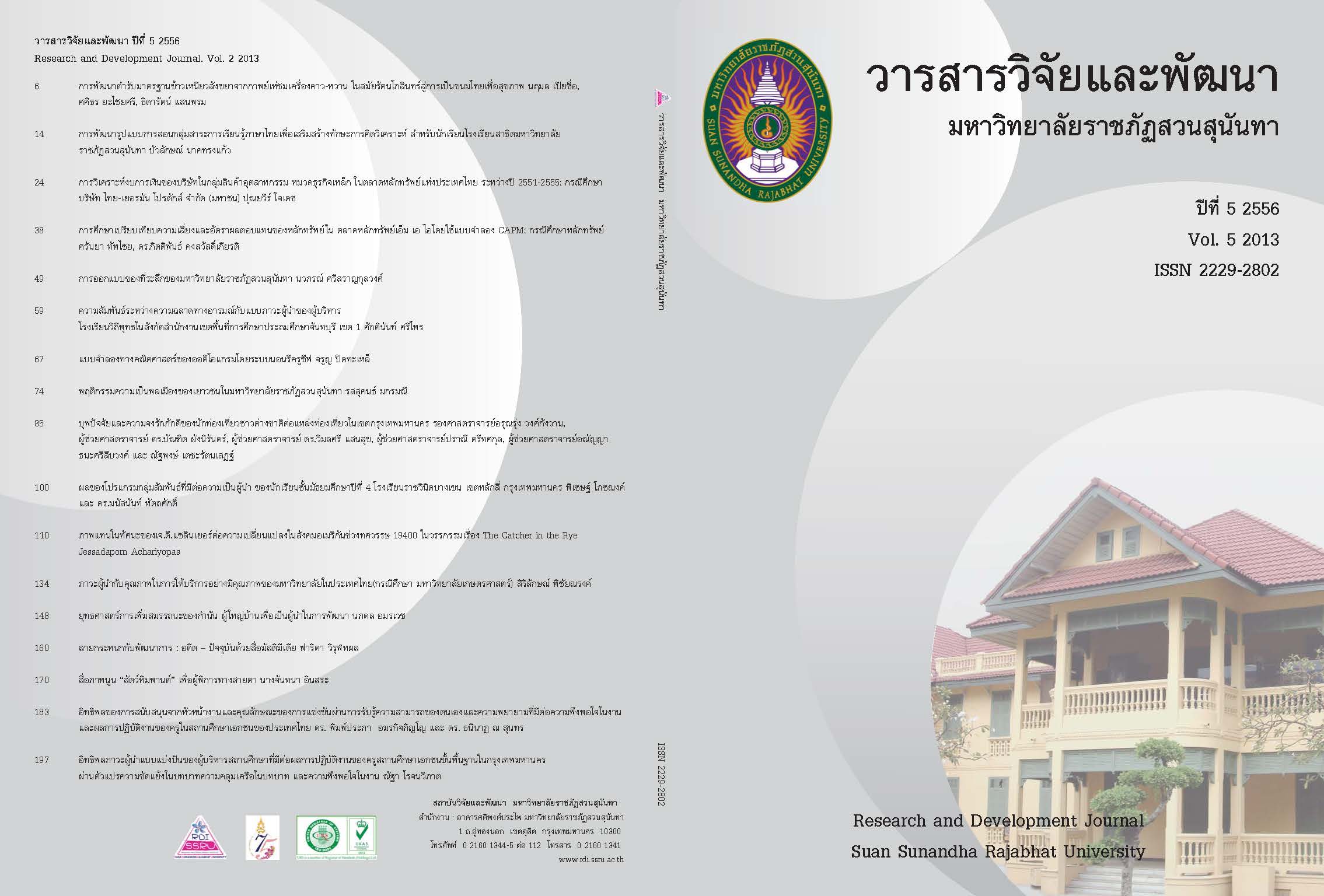ภาวะผู้นากับคุณภาพในการให้บริการอย่างมีคุณภาพของมหาวิทยาลัย ในประเทศไทย(กรณีศึกษา มหาวิทยาลัยเกษตรศาสตร์)
DOI:
https://doi.org/10.53848/irdssru.v5i1.214324คำสำคัญ:
ภาวะผู้นา, คุณภาพบริการบทคัดย่อ
ปี พ.ศ.2507 ได้เริ่มมีแนวคิดในการนามหาวิทยาลัยออกนอกระบบหรือสถาบันอุดมศึกษาในกากับของรัฐบาล ซึ่งหมายถึงสถาบันอุดมศึกษาของรัฐที่มีการบริหารการจัดการอิสระแยกจากระบบราชการ (Autonomous University) แต่ยังได้รับเงินอุดหนุนทั่วไป (Block Grant) ที่รัฐจัดสรรให้เป็นรายปี เพื่อใช้จ่ายตามความจาเป็นในการดาเนินการตามวัตถุประสงค์ของมหาวิทยาลัยและเพื่อการประกันคุณภาพการศึกษา การเพิ่มประสิทธิภาพของมหาวิทยาลัยนั้นขึ้นอยู่กับปัจจัยหลายด้าน มหาวิทยาลัยเป็นองค์กรที่สามารถพัฒนาได้ มีวัฒนธรรม มีเป้าหมายและมีลักษณะเฉพาะของตนเอง มีการเติบโตและเปลี่ยนแปลงไปตามสภาพแวดล้อม ตามเทคโนโลยี ตามพฤติกรรมของคนในองค์กร ดังจะเห็นจากทฤษฎีองค์กรส่วนใหญ่มุ่งเน้นไปที่เป้าหมายขององค์กร โครงสร้าง กลยุทธ์ และการขยายขนาดขององค์กร สภาพแวดล้อม (Gladys L. Symons, 2001, หน้า 85-96) โดยเฉพาะเรื่องของภาวะผู้นาและการพัฒนาทรัพยากรมนุษย์ โดยมีวัตถุประสงค์คือต้องการศึกษาปัจจัยด้านภาวะผู้นามีอิทธิพลต่อปัจจัยด้านความผูกพันต่อองค์กรในมหาวิทยาลัยตามการรับรู้ของอาจารย์ เจ้าหน้าที่หรือพนักงานและนักศึกษา และปัจจัยด้านความผูกพันต่อองค์กรมีอิทธิพลต่อปัจจัยด้านคุณภาพบริการของมหาวิทยาลัย ตามการรับรู้ของอาจารย์ เจ้าหน้าที่หรือพนักงานและนักศึกษา ในการศึกษาครั้งนี้ได้ทาการเก็บข้อมูลจาก ผู้บริหารอาจารย์ เจ้าหน้าที่หรือพนักงานและนักศึกษา ทั้ง 4 วิทยาเขตในมหาวิทยาลัยเกษตรศาสตร์ การศึกษาในครั้งนี้ได้ทาการศึกษาและเลือกตัวอย่างเพียงมหาวิทยาลัยเกษตรศาสตร์เพียงแห่งเดียวพบว่าปัจจัยด้านภาวะผู้นาส่งผลต่อปัจจัยด้านความผูกพันต่อองค์กร และปัจจัยด้านความผูกพันยังส่งผลต่อคุณภาพบริการของมหาวิทยาลัย
เอกสารอ้างอิง
ความผูกพันกับองค์การของพนักงาน บริษัท เอฟ
แอนด์เอ็น แดรี่ส์ (ประเทสไทย) จากัด. กรุงเทพ:
มหาวิทยาลัยราชภัฎธนบุรี.
[2] ธัญรัศม์ คงปรีชา. (2552). ความทุ่มเทและความ
ผูกพันต่อสถาบันการศึกษาของนักศึกษาระดับ
บัณฑิตศึกษา มหาวิทยาลัยราชภัฎจันทร์เกษม.
กรุงเทพ: มหาวิทยาลัยราชภัฎจันทร์เกษม.
[3] ประภัทศร เหลืองประเสริฐ. (2548). ภาวะผู้นาของ ผู้บริหารระดับสูงกระทรวงศึกษาธิการในอนาคต.
กรุงเทพ: มหาวิทยาลัยราชภัฎสวนสุนันทา.
[4] ปทิตตา สัณหภักดี. (2550). ปัจจัยจูงใจที่มีผลต่อ
พฤติกรรมในการทางานและความจงรักภักดีต่อองค์กร
ของพนักงาน บริษัท บีแอนด์อี จากัด. กรุงเทพ:
มหาวิทยาลัยศรีนครินทรวิโรฒน์
[5] แวววรรณ ละอองศรี. (2551). ความผูกพันต่อ
องค์การของพนักงานบริษัทเฟดเดอรัลเอ็กซ์เพรส
(ประเทศไทย)จากัด. เชียงใหม่:
มหาวิทยาลัยเชียงใหม่.
[6] สาวิตรี พูลสมบัติ. (2550). ความสัมพันธ์ระหว่างการ
รับรู้ความเหมาะสมระหว่างคนกับงาน กับความพึง
พอใจในงานและความผูกพัน์ต่อองค์การของพนักงาน.
กรุงเทพ: มหาวิทยาลัยเทคโนโลยีพระจอมเกล้าพระ-
นครเหนือ.
[7] หทัยรัตน์ ตันสุวรรณ. (2550). ปัจจัยด้านวัฒนธรรม
องค์กรความจงรักภัคดีต่อองค์กร และบรรยากาศใน
องค์กรที่มีผลต่อประสิทธิภาพการทางานของพนักงาน
การนิคมอุตสาหกรรมแห่งประเทศไยทยสานักงาน
ใหญ่. กรุงเทพ: มหาวิทยาลัยศรีนครินทรวิโรฒน์.
[8] Bill Merrilees, Carmel Herington Hugh Wilkins.
(2007). Towards an understanding of total
service quality in hotels. Hospitality
Management, 840-853.
[9] Catherine Bailey, Joanna Burr Martin Clarke. (2008). Leadership development: making a difference in unfavourable circumstances. The Journal of Management Development.,
824.
[10] Chandrasekharan Rajendran and L. Prakash
Sai Bindu Narayan. (2008). Scales to
measure and benchmark service quality in
tourism industry A second-order factor
approach. Benchmarking: An
International Journal, 469-493.
[11] Daniel L. McCollum and Lawrence T. Kajs.
(2007). SCHOOL ADMINISTRATOR EFFICACY:
ASSESSMENT OF BELIEFS ABOUT
KNOWLEDGE AND SKILLS FOR SUCCESSFUL
SCHOOL LEADERSHIP. Teaching Leaders to
Lead Teachers: Educational Administration in
the Era of Constant Crisis Advances in
Educational Administration, 131–148.
[12] Dawn Kelly. (2000). Using vision to improve
organisational communication. Leadership &
Organization Development Journal, 92-101.
[13] Eftihia Nathanail. (2008). Measuring the
quality of service for passengers on the
hellenic railways.
Transportation Research Part A, 48-66.
[14] Gladys L. Symons. (2001). POSTMODERN FEMINISM CHALLENGES ORGANIZATION THEORY. An International Feminist
Challenge to Theory, 85-96.
[15] James J.Jiang,Gary Klein, Christopher L.Carr
(2002). Measuring Infomation System Service
Quality: SERVQUAL from The other side.
Measuring IS Service Quality, 145-166.
[16] Jung-Yu Lai and Chun-Yi Chou. (2008). A
Strategic Approach of Internal Service
Quality for Improving Employees’ Job
Satisfaction in E-business. SIGMIS-CPR’08,
141-150.
[17] Kerry Barnett and John McCormick. (2003).
Vision, relationships and teacher motivation:
a case study. Journal of Educational
Administration, 55-73.
[18] Ling-Feng Hsieh, Li-Hung Lin, Yi-Yin Lin.
(2007). A service quality measurement
architecture for hot spring hotels in Taiwan.
Tourism Management, 429-438.
[19] Maxwell K. Hsu,Godwin J. Udo Festus
Olorunniwo. (2006). Service quality,
customer satisfaction, And behavioral
intention s in the servic e factory.
Journal of Services Marketing, 59-72.
[20] Naceur Jabnoun and Aisha Juma AL Tasasi.
(2005). Transformational leadership and
service quality in UAE hospitals. Managing
Service Quality, 70-81.
[21] Niki Glaveli and Eugenia Petridou, Chris
Liassides, Charalambos Spathis (2006). Bank
service quality: evidence from five Balkan
countries. Managing Service Quality,
380-394.
[22] Peter Sleegers, The Netherlands Kenneth
Leithwood and Doris Jantzi Femke Geijsel.
(2003). Transformational leadership effects
on teachers’ commitment and effort toward
school reform. Journal of Educational
Administration, 228-256.
[23] Riadh Ladhari. (2008). Alternative measures
of service quality: a review. Managing
Service Qualit, 65-86.
[24] Shun-Hsing Chen, Ching-Chow Yang and
Jiun-Yan Shiau, Hui-Hua Wang (2006). The
development of an employee satisfaction
model for higher education. The TQM
Magazine, 484-500.
[25] Siu Loon Hoe. (2007). Shared vision: a
development tool for organizational
learning. DEVELOPMENT AND LEARNING IN
ORGANIZATIONS, 12-13.
[26] Sooksan Kantabutra and Gayle C. Avery.
(2007). Vision effects in customer and staff
satisfaction: an empirical investigation.
Leadership & Organization Development
Journal, 209-229.
[27] Steers, R.M., Porter, L. (1991). Motivation
and Work Behavior. 5th edition. New York:
Mcgraw-Hill. Hoy. Wayne K. ; & Rees,
Richard. (1974,Winter). Subordinate Loyalty
to Immediate Supperior: A Neglected
Concept in the Study of Educational
Administration. Sociology of Education.
47:274 - 275.
[28] Terje Slatten. (2009). The effect of
managerial practice on employee-perceived
service quality The role of emotional
satisfaction. Managing Service Quality,
431-455.
[29] UgurYavas, EminBaba Osman M. Karatepe.
(2005). Measuring service quality of banks:
Scale development and validation.
Journal of Retailing and Consumer Services,
373-383.
[30] Walter Wymer Jr and Injazz Chen Faye
X.Zhu. (2002). IT-based services and service
quality in consumer banking. International
Journal of Service Industry management,
69-90.
ดาวน์โหลด
เผยแพร่แล้ว
รูปแบบการอ้างอิง
ฉบับ
ประเภทบทความ
สัญญาอนุญาต
บทความที่ได้รับการตีพิมพ์เป็นลิขสิทธิ์ของ สถาบันวิจัยและพัฒนา มหาวิทยาลัยราชภัฎสวนสุนันทา
ข้อความที่ปรากฏในบทความแต่ละเรื่องในวารสารวิชาการเล่มนี้เป็นความคิดเห็นส่วนตัวของผู้เขียนแต่ละท่านไม่เกี่ยวข้องกับมหาวิทยาลัยราชภัฎสวนสุนันทา และคณาจารย์ท่านอื่นๆในมหาวิทยาลัยฯ แต่อย่างใด ความรับผิดชอบองค์ประกอบทั้งหมดของบทความแต่ละเรื่องเป็นของผู้เขียนแต่ละท่าน หากมีความผิดพลาดใดๆ ผู้เขียนแต่ละท่านจะรับผิดชอบบทความของตนเองแต่ผู้เดียว





